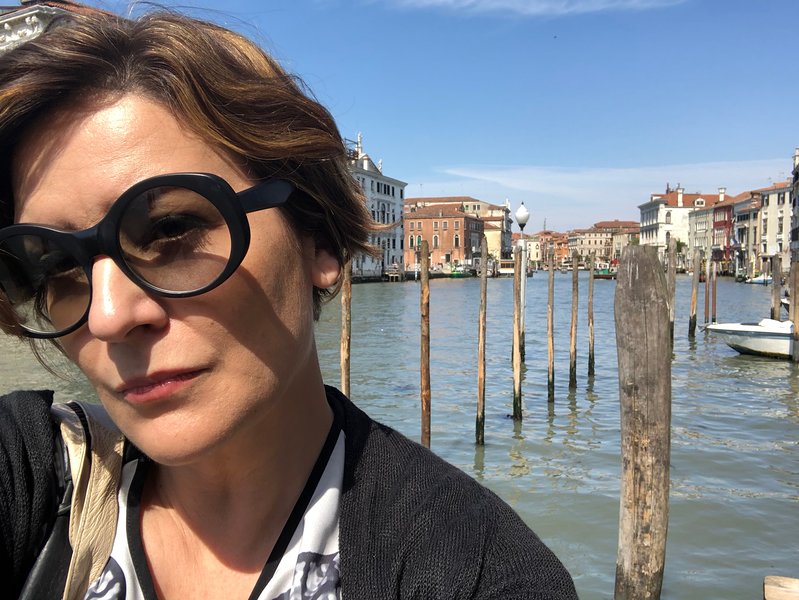I just returned from a few days in Italy, and a business meeting near Venice brought the opportunity to hop in to Venice proper for a few hours. Even though I have visited Italy many times since my studies abroad there 22 years ago, I had revisited Venice. During my studies abroad in Italy, I got to know the wondrous city on water fairly well, having returned many times to see its many surreal faces: sunny and unbelievably crowded, flooded and damp, even snowy.
Visiting Venice always brings to my mind Italo Calvino's "Invisible Cities," a mind/eye opening must read for architecture students. In the book, Calvino describes a series of impossibly absurd cities, and after reading several of these descriptions, one arrives at the conclusion that many of these stories actually describe real cities, and many presumably Venice. Calvino isolates certain aspects of the cities, allowing readers to focus on just those, and their absurdity, to imagine fantastic places in which these aspects are ever-present. Venice feels very much like an Impossible City and, in many ways, it is, and it has, in fact, many Invisible Cities within it. It is absurd, and beautifully so, as a whole, and each of its many layers/narratives.
At the time I first visited Venice, I was also very interested in the parallels between architecture and poetry. My architecture thesis was ultimately about just that, and perhaps Venice (or Italo Calvino, or Fernando Pessoa) had something to do with it. Of particular interest to me was the mechanism of transposition or, to put in architectural terms, collage. Transposition in poetry collages different, often unrelated narratives, generating a third, unforeseen narrative: an invention. In poetry, the beauty of that new narrative, much like in Venice, lies in its subtle absurdity. It is almost real, almost normal, but not quite. There are so many unique aspects to Venice's architecture as a result of its conditions, and they are not all obvious. Overall they contribute to its uniqueness and beauty. The canals are the main narrative, but there is so much more; there are so many layers to it, and so many inventions within it.
Many architects' work is described as poetic, often without much of an explanation. In my view poetry in architecture comes from its ability to re-present reality to us in a slightly absurd, unexpected way, either through the collage of different realities or, like Calvino, by highlighting certain aspects of a building and forcing us to confront them in isolation, to the point that they take over the narrative. When done right, it is subtle yet self-evident to the discerning eye.
Practicing architecture in a highly regulated urban environment such as Washington DC, can make one forget the importance of absurdity in architecture. We are expected to design buildings that fit in, don't offend, don't provoke, that are respectful, and certainly not daring, and are often criticized for not doing so. This is particularly the case when proposing interventions on existing buildings, combining old and new, or working in a Historic District. I tend to be somewhat fearless about doing major surgery on older buildings, and non-apologetic about proposing contemporary buildings in Historic contexts. A linear, singular narrative seems to be the only thing people comprehend, preferably one about a bi-gone era. Most of us know that simply regurgitating the past, and designing for crowd pleasing is not how good architecture, or good cities are made. Good architecture, good cities are complex, layered, and absurd, not linear, precious, or apologetic.
Venice is bold in its absurdity, in its refusal to simply be like other cities. Imagine if Venice had never existed and someone proposed building it today in one shot, what kind or censorship would they have encountered? Obviously, Venice, like other great European cities, emerged organically over centuries. Luckily, they were never subjected to an ANC or Historic Preservation review. No one tried to oppose building Venice say for safety reasons, or to preserve the marsh, or to claim the streets are too narrow. It would have never existed. The fact that Venice is a whole city, not just a building, makes its existence even more implausible. Yet it exists, in all its beautiful absurdity, at least for now.
For better or for worse, Venice is now one of the most protected cities in the world, and one that it is virtually impossible to build anything new in. Its evolution has been halted, and it is now an object to be consumed by mass tourism. What would have happened if that were not the case? Would another layer of passageways/bridges have been built at a higher level, would the roofs have become connected between themselves providing more options for mobility? Where would the seeming absurdity have ended? Would it have ended at all? Would it be less or more memorable if it had continued to evolve?
Often people confuse beauty with appearance, hence the urge to freeze it in time, to mummify it. To me beauty has always been much more about substance, especially when it comes to architecture. By halting a city's natural evolution in order to preserve it, you can also kill its soul. Mummies are dead, after all. Venice has plenty of substance, and will forever be beautiful, but it will never be more beautiful than it is today. Luckily, there is still plenty of room for growth and invention elsewhere.
I'm glad I took the time to drop in, even if only for a short while.






